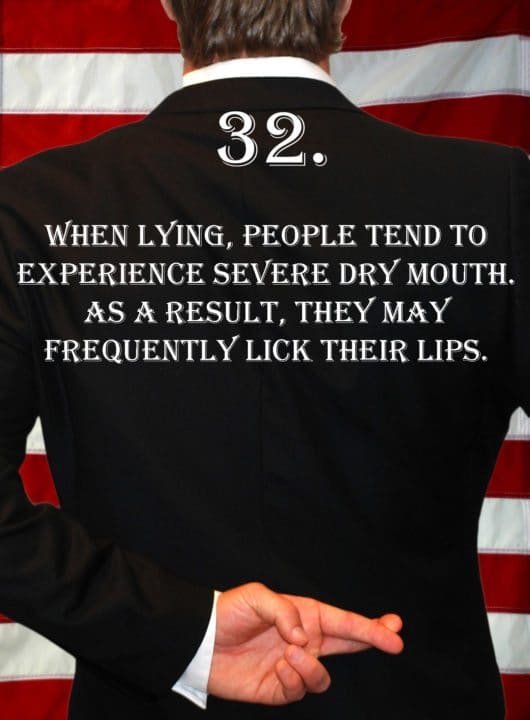
Deception Tip 11:
Liars will seize any opportunity to be believed. Therefore, it is very likely that the liar will accept lies told by the target even if they may be incriminating.
Listen To The Podcast!
E11 – Accepting Lies – Deception Tips Podcast – Click Here To Subscribe
Podcast Transcript
Hello, and welcome to the Deception Tips Podcast, where you will learn amazing cues to detect deceit that will help you read people like never before. I’m your host, Spencer Coffman. Let’s get started.
Welcome to episode 11 of the Deception Tips Podcast. Last time, we talked about a verbal sign of deception that is fairly easy to recognize. It is a quick answer of “yes” or “no” followed by a longer explanation.
Now, over the last couple of weeks, or the last few weeks, we have talked about verbal signs of deception and they have been in responses, and in answers, of “yes,” “no,” negative, positive, and we’ve talked a lot about yes-or-no questions.
The one thing you need to remember in any type of response when looking for deceptive behaviors, or seeking out deception in verbal signs of deception, is anytime a yes-or-no question is asked, the obvious response is ‘yes’ or ‘no.’ I know that sounds basic, but it is basic. It is very simple.
Therefore, when questioning people, when trying to seek out lies, yes-or-no questions are your best ally because when people give responses to a yes-or-no question, they should often be ‘yes’ or ‘no.’ If they’re something other than ‘yes’ or ‘no,’ then you need to dig in.
Now, that being said, yes-or-no questions are not the only part of an interrogation. Oftentimes, you want the liars or the people who are being questioned, to talk more.
Therefore, yes-or-no questions will not get them to talk more because you’re giving them an easy opportunity to not talk. But, they can be used because some liars will seize that opportunity of yes-or-no and then explain and expand upon their answer.
Those are the types of liars where yes-or-no questions are very beneficial because that is an easy way to tell if they’re lying because if it’s a yes-or-no question, the answer should be ‘yes’ or ‘no,’ but if they keep going, now there’s a red flag.
However, if you were to ask me questions, if you ask me yes-or-no questions, I would say ‘yes’ or ‘no.’ So, if you want to get more out of me personally, you would need to start asking more open-ended questions that are not yes-or-no responses. Because then I would be forced to talk, to explain more. This is why yes-or-no questions may work better for some people and not others.
You need to have all different types of questions in your repertoire. But basically, from the past couple of weeks of our discussion, if someone expands on a yes-or-no question, if they make statements different than what they were, if they answer quickly and think about it, then you need to watch for some other verbal signs of deception or some other nonverbal signs of deception. Because it’s very likely that they are lying, or they are about to lie.
Today, we are going to talk about a different sign of deception. We’re going back to a sign that is not even on the body and it’s not verbal. It is more of a sign of agreement or acceptance. It is a sign that occurs entirely within the liar’s mind.
So, for you to see it, it’s really nothing they do, it’s more of what you can do to see and confirm that they may or may not be lying. This is a sign that is entirely under your control. It is like your secret weapon, that you can use to confirm or deny any suspicions you may have.
If you think you saw some clusters or patterns of behavior. If you’re wondering whether or not they’re immediate responses of ‘yes’ or ‘no,’ or they’re delayed explanations, or they’re converting statements from positive to negative and negative to positives.
If you’re questioning whether there may be lies or not, you can pull this little secret weapon out and use it to determine whether or not they are lying or are telling the truth.
So, here it is, Deception Tip 11: Liars will seize any opportunity to be believed. Therefore, it is very likely that the liar will accept lies told by the target even if they may be incriminating. Here it is again. Liars will seize any opportunity to be believed. Therefore, it is very likely that the liar will accept lies told by the target even if they may be incriminating.
What does this mean? This means, that if you are going to catch a liar, you may have to lie to do that. What’s that old saying? To catch a thief, you have to think like a thief? Or send a thief to catch a thief? Something like that.
Or does it take a gypsy to catch a gypsy? It always takes one to know one. If you are going to catch a liar, you may have to put the tables back to them. The shoe on the other foot. Turn those tables around, give them a lie that you know is false and see how they react to it. If they accept a lie, even if it’s incriminating, they may do it because they want to be believed.
So, if they’re telling you a lie and you start to take one portion of that story that you know is false because maybe you have some other evidence that you haven’t presented to them yet, you can turn that and spin it into a lie of your own that gives them the confirmation that “Wow. They’re really believing me.” You can suggest a story.
Like, “So when you say that this went like this, then this happened and this happened and it was like this and you did this?” And they will be like, “Yeah! That’s right. That’s what I did.” Even though you know that was false and even though they just admitted to doing something.
They seize any opportunity to be believed. This is their consciousness. Their conscious mind wants to get that lie out and wants to be believed almost like it’s working for the approval of the unconscious. When the unconscious and the conscious are fighting, there is a lot of tension.
We’ve talked about this before. There is so much tension building up inside the liar’s mind, inside their body. They’re anxious. This is why it is sometimes very easy to see. They may be sweating. They may be fidgeting. They’re doing all this stuff that they can to release this tension and this pressure within them. They’re trying to tell the lie fast. They are trying to get it out. They are trying to get people to believe them.
So, when they hear that you might be believing them, even though you are suggesting something that may incriminate them and that you know is false, they may latch on to it instantly and run with it. And maybe they may even start spinning a story to try and bring it on.
This happens all the time with kids. Parents always say stuff like, “Oh, really? Then you must’ve done this right?” “Yeah! And then, this happened, and this happened and then I did this…” And the parent is sitting there like “uh-huh.” They know that it was false. They just gave them something to work with to see if that kid would continue to lie or if they would say “No. That’s not what happened. I did this.” And then they tell the truth.
Interrogators, parents, and targets can use these forms of lies. They use the material the liar can give them, and spin it back on them, and that is a very good way to tell whether or not they are lying. And we are going to talk even more about it, coming up after this.
It doesn’t take long to read and it’s filled with tips on detecting deception. It’s Spencer Coffman’s Deception Tip e-book and contains over 100 cues to detecting deception. Available on Spencer Coffman’s website or any major retailer.
Liars love to be believed. That is their sole purpose in telling the lie. They want someone to believe that lie. Therefore, when you show signs that you are starting to believe their lie, that is going to give them an immense amount of relief and satisfaction. These are signs that we are going to talk about later on. This is another trick interrogators can use.
If they pretend to believe the liar and then watch for that liar to show signs of relief, satisfaction, or over-confidence, or signs of superiority, contempt, laughing almost. Anything like that. They know then, that that would be a lie because if I pretend to believe you and you, all of a sudden got cocky. Normally, when you believe someone or when somebody believes you, you don’t become cocky. But, if you think that you’ve fooled them, now you may get more of an inflated head than normal.
So, that’s another trick by interrogators that they can do that to see those different signs and- again we’ll talk about them in another episode- but the bottom line here is liars want to be believed. They love to be believed.
The tensions within, inside them, are so much that when any signs of belief come about, the conscious takes a deep breath and the unconscious start to kind of let its guard up because it doesn’t really know what’s happening. It says, “Wait a minute. I lost. The lie was believed. I didn’t leak enough signs of deception.” So then, they start to leak relief and joy, and things like that to keep trying to get people to notice that the conscious is up to no good.
The unconscious ALWAYS wants the truth to come out. It never fails. It works so hard to let the truth come out. And when a liar is about to be believed, the conscious starts to get inflated. The conscious is always up to stuff that’s no good.
It’s either trying to lie, or it’s feeling much better about itself than it should. It’s arrogant or it is deceptive. That is it. The unconscious is always truthful, always sincere, and always good with normal people. That is how it works. So, when the conscious is about to be believed and the unconscious knows that it’s a lie, now there’s even more conflict. The conscious is happy. The unconscious is disappointed and more behaviors will come out.
So, there are always signs of deception out there. When you are interrogating or talking with someone, if you suggest a lie, even if it’s incriminating, the liar may start to believe you simply because they are so desperate to be believed.
Even if it incriminates themselves, they may latch on to your story and continue on. This is often the case when people may suggest a lesser sentence or a different crime to get someone to fess up to something.
For example, a great technique that people use is if someone is accused of some kind of little thing, like, I say, “Why didn’t you take the trash out this morning?” and I’m accusing you because you didn’t do it, and I know you didn’t do it, and you are lying to me saying, “No. I took it out. I did this. I did this.” Then I might say, “Well, when you took it out, you broke the trash can, and now you need to buy a new one because it’s broken in the street.” Then you may say, “Wait a minute! No! I didn’t take out the trash. It wasn’t me!”
I just accused you of a greater crime to get you to fess up to a lesser crime. I converted your lie into you telling the truth by incriminating you or threatening to incriminate you, with something even more.
But it wasn’t a threat, it was more of a statement, like a fact. It was something that happened and you fessed up to your little lie because you didn’t want to catch the blame for something else that occurred with that lie.
Although this isn’t accepting a lie, this is getting someone to fess up to the lie by accusing them, or by putting the blame for something greater, a greater crime, onto them. This is the same mentality and defense mechanisms that exist when suggesting a lie that the liar will accept.
If you suggest a lie, or a story, about something that you extracted from the liar’s story and you put it together in your mind like, say, “let me get this straight,” and then you explain whatever it is, and add in some pieces of your own- maybe with some real facts, and also corroborating bits of their story in with the scenario that you are trying to understand, or that you are saying you are trying to understand- then turning it to them and letting them run with it, they’re going to believe that you are believing their story.
They’ll say, “Man. I’m getting somewhere. They just repeated it back to me. They just added in some facts that I didn’t bring up. They’re really starting to believe me.” They may take that like and maybe start to run with it a little bit more and say, “Yeah. In this part, you missed this, and here you missed that,” and they’re going to continue adding to it. Even if it puts them in a different bit of fault because they want to be believed. They know they are going to get off with something, even if they have to fess up to something else.
For example, if we reverse that scenario with the trash can and say, “You broke that trash can when you did whatever.” And you may say, “No.” and we could go on and on about it, but then I could suggest something about you taking out the trash, or you not taking out the trash, and you say “You’re right. I didn’t take out the trash.” And I’ll say, “Aha! I knew you didn’t take it out!” But because we were talking about something else, and now you were incriminated for a lesser crime of actually not taking out the trash.
The scenarios can always be reversed when talking to someone. You can use their tactics against them. It is like Judo. If you use their momentum and their leverage against them, it often winds up to be an even bigger weapon because now they start to attack themselves. They’ll trip over themselves.
They will admit different things that they didn’t admit before. They’ll start to feel a little bit off with themselves because, normally, when someone lies they expect not to be believed. Because like we talked about they are working so hard to convince themselves of the lie that they don’t realize it is much easier to convince other people than themselves.
They expect not to be believed. When they start to be believed, it is a feeling that they don’t know what to do with. This is why if you start to believe them, suggest a story, they will latch on to it, and continue to run with it, oftentimes winding up incriminating themselves even more or making it readily apparent that they are lying. Even though this isn’t a verbal sign of deception or a nonverbal sign of deception, it is a sign that you have complete control over and you can use it anytime you need to determine whether or not someone is lying.
I want to thank you for listening to today’s episode of the Deception Tips Podcast. I encourage you to share it with your friends, subscribe to the feeds, take a look at the Deception Tips blog, check out my books, and tune in every week for a new Deception Tip.
Video Transcript
My name is Spencer Coffman. Thank you for watching the Deception Tips videos. They’re all about teaching you how to read people and detect deception so that you will be able to tell if someone is lying to you.
Today, we are going to talk about a cool tip about suggesting certain answers and getting people to admit to things by giving them something to work with. It’s a little tactic that you can use to catch people in their lie. It’s something that you can bring about once you already suspect them. Once you’ve asked a few other questions, and maybe you’ve noticed some certain deceptive behaviors that they’ve exhibited and you’re wondering whether or not they are telling the truth. Or whether they are not telling the truth, and you need that little extra thing to convince yourself, or to prove, whether or not they are being deceptive.
So here it is. This is Deception Tip number 11: Liars will seize any opportunity to be believed. Therefore, it is very likely that they liar will accept lies told by the target even if they may be incriminating. So, this is important because, if they liar really wants to be believed- which they do. All liars want to be believed or they wouldn’t be telling a lie. They would be telling the truth.
Now, when they want to believe, sometimes that urge is so strong that if the target, that is the person being lied to if they start suggesting things, such as adding different elements to the story or giving them material to work with, the liar may seize that and hang onto it. They’ll latch on to that information and run with it. If that is the case, the target can be certain that that person is lying because they know that that information is false.
It’s like planting a seed. They give them a little false seed to work. If they liar starts working with it, now they can be certain. “Well, now I know there’s lying because I gave him some false information and they’re telling it like it’s part of their story.”
Now, that’s the one side of it. That they can use that information and enhance their lie and then the target obviously knows that it’s false. So, it’s pretty much a drop in the bucket. It’s a dead sign that they are lying because you’ve handed them something that you know is false and they’ve started using it. That proves your point.
Now, the other side of this is something that the target could start suggesting different information, and it might be incriminating. So, like littler things. So, if you’re trying to get somebody to fess up to a greater crime- whether or not you’re trying to get people to fess up to crime is something, but- something greater, with a greater consequence, or a greater perceived consequence, then you might suggest littler things as a part of their story. Like, “Oh yeah, and you trespassed during that.” Or, “You left the door open.” Or something like that. You’d use little things that are seemingly insignificant, without consequence and they might say “yes” and add to them to corroborate their story.
So, if they said, “Yeah. Did you go over to so-and-so’s house and mow the lawn last week?” “Yup. Yup. I did.” And you know that they might be lying and you say, “Oh, because the door might have been open.” “Oh, yea! I must’ve forgot to lock the door.” And you know that, well they never went over there because the door was locked and now you know they just incriminated themselves by admitting to something that was seemingly insignificant but was still something that isn’t good. But, they admitted that and they took part of your suggestion, which is part of the story that you know is false, and started using it.
So, that’s two things that the liar has incorporated because they thought that the target believed them. So, this is very important. Even if the target doesn’t believe what they liar is saying, the perceived element of belief will go a long way in getting the liar to admit to something or to run with a story that the target knows to be false.
They seize any opportunity to be believed and if the target is showing any signs of belief, by saying certain things or by adding to their story or saying, “Oh yeah, and then what did you do?”- kind of encouraging them or building them up in that lie, then they will continue to talk because they think that they are being believed. And they will start to loosen up which means more signs of deception will come out.
If this is your first time watching these videos, I would love to have you subscribe to the channel on YouTube. Feel free to comment on them with any questions you may have. In addition, if you’d like some more information, we’ve got books, podcasts, e-books, blog posts all available on spencercoffman.com that are dedicated to teaching you how to read people and detect deception so that you will know exactly what every body is saying.
Until next time.






